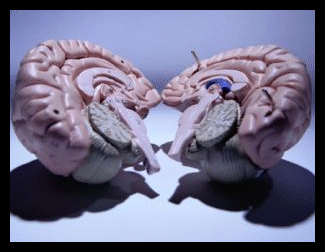
There's gotta be a reason. You can't have an event pass by you without knowing why, right? Right.
"Well, you know, the weather made it hurt. It's all that rain..."
"My back is hurting today, I was at a family BBQ and I stood for an hour yesterday, so..."
"The knee feels much better, I think it was the tape you put on there."
Post Hoc Ergo Proctor Hoc. After that, therefor because of that.
Making a reason for things is not conscious, often. We always see cause and effect as a truth. If we're wrong, it's confabulation, not a lie. It's "only human." See a quote below from some of the Split Brain research:
Gazzaniga developed what he calls the interpreter theory to explain why people — including split-brain patients — have a unified sense of self and mental life3. It grew out of tasks in which he asked a split-brain person to explain in words, which uses the left hemisphere, an action that had been directed to and carried out only by the right one. “The left hemisphere made up a post hoc answer that fit the situation.” In one of Gazzaniga's favourite examples, he flashed the word 'smile' to a patient's right hemisphere and the word 'face' to the left hemisphere, and asked the patient to draw what he'd seen. “His right hand drew a smiling face,” Gazzaniga recalled. “'Why did you do that?' I asked. He said, 'What do you want, a sad face? Who wants a sad face around?'.” The left-brain interpreter, Gazzaniga says, is what everyone uses to seek explanations for events, triage the barrage of incoming information and construct narratives that help to make sense of the world. The Split Brain: A Tale of Two Halves. Nature, 2012.
A corpus callosotomy was a surgical severance of the corpus callosum to prevent seizures. Was= past tense, it's not done currently to my knowledge. These "split brain" patients were a wealth of investigation to researchers, considering the main neural highway between hemispheres had been cut.
In addition to the above example, there are other examples among the split-brain patients, as they try to make sense of the world while being unable to utilize the complexities of an interwoven brain. One individual viewed a movie clip (through the left eye and into the right hemisphere) which was scary in nature. This information was "cut off" from both verbal and reasoning neural networks of the left hemisphere. The researcher asked the patient how he felt. The patient reported he felt uneasy, and said that the researchers were bothering him and being creepy. Confabulation of a reason for the feelings he was experiencing.
You gotta have a reason.
*Plausibility and cause and effect are discussed around 6 minutes in*
*See also You Are Not So Smart Podcast: Misremembering with Julia Shaw
Don't forget this is what we do. We humans. We find causes, right or wrong. We have to know what is going on. Reality is how we see it, and sometimes it's not reality at all. I don't know if this is a plea to understand humanity, or a plea to please respect the objective research process... or both.
Yeah, I think both.
-Matt Dancigers, DPT
Gazzaniga MS. Forty-five years of split-brain research and still going strong. Nature. 2005; 6: 653-659
Roser ME, Fugelsang JA, Dunbar KN, Corballis PM, Gazzaniga MS. Dissociating processes supporting causal perception and causal inference in the brain. Neuropsychology. 2005; 19(5): 591-602
Interested in live cases where I apply this approach and integrate it with pain science, manual therapy, repeated motions, IASTM, with emphasis on patient education? Check out Modern Manual Therapy!
Keeping it Eclectic...















Post a Comment
Post a Comment